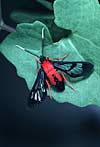A gift of poison: moths and safe sex
 Safe sex for scarlet-bodied wasp moths means avoiding being eaten by predators while mating. So, the male moth, in order to protect his intended during courtship, covers her with a bridal veil of poison, says William Conner, professor of biology at Wake Forest University. The moths are immune to the toxin, but the poisonous cloud prevents predators from spoiling the wedding of the insect pair.
Safe sex for scarlet-bodied wasp moths means avoiding being eaten by predators while mating. So, the male moth, in order to protect his intended during courtship, covers her with a bridal veil of poison, says William Conner, professor of biology at Wake Forest University. The moths are immune to the toxin, but the poisonous cloud prevents predators from spoiling the wedding of the insect pair.
The scarlet-bodied wasp moth, native to Florida, is the only insect known to transfer a chemical defense in this way, says Conner. He discovered the moth’s distinctive behavior while conducting research at the Archbold Biological Station near Lake Placid, Fla.
 Conner’s study will be published in the Proceedings of the National Academy of Sciences today, Dec. 12. Co-authors of this study include former Wake Forest graduate student, Ruth Boada, and Thomas Eisner, Andres Gonzalez, Frank C. Schroeder and Jerrold Meinwald of Cornell University.
Conner’s study will be published in the Proceedings of the National Academy of Sciences today, Dec. 12. Co-authors of this study include former Wake Forest graduate student, Ruth Boada, and Thomas Eisner, Andres Gonzalez, Frank C. Schroeder and Jerrold Meinwald of Cornell University.
As a caterpillar, the insect feeds on a non-toxic plant, climbing hempweed. Then, when it becomes a moth and is ready to mate, the male changes his eating habits. As darkness falls on his big night, he visits the poisonous dogfennel plant. Dogfennel is easy to spot in pastures, says Conner, because the cows eat all the grass around it, but leave the tall toxic plant standing.
The male moth extracts toxins called “pyrrolizidine alkaloids” from the plant.
“He lands on the plant, regurgitates on the plant to dissolve the alkaloids and then reimbibes the toxin-rich liquid,” says Conner.
The small red and black moth stores the toxins in a special pouch. The pouch, located on his underbelly, is filled with fibers that have a cotton candy consistency.
Once he has ingested the toxin from the plant, the male is no longer tasty to his common predators, particularly spiders and bats. After gathering the poison, the moth goes in search of a female. When he finds his insect bride, they mate for nine hours. But, just before mating, the moth releases the toxin like a cloud of miniature confetti that sticks to the female. The toxin protects her while she is mating and while she lays her eggs. The female moth then passes the toxin to her eggs. The toxin deters egg-eating insects like ants and ladybugs from devouring her young.
To test whether the toxin was effective in protecting the adult moths, Conner and his Wake Forest student assistants placed the moth in the web of a golden orb-weaving spider. Instead of eating the moth, the spider released the moth by cutting it free from its web.
As part of their analysis of the transfer of the toxin from the male to the female, Conner and his research assistants have recorded videos of the male releasing the toxins before mating.
Conner, his wife Mindy, and several student assistants have been working on this project since 1996.
The research sheds light on the evolution of sexual signals in insects, says Conner.
“The link between chemical defenses and sex appears to be a strong one,” he says. “Just as early human females probably preferred males that could help defend them and their household, it makes sense for female insects to choose males that can provide a good defense for them and their offspring.”
Conner spends a couple of months each year studying the scarlet-bodied wasp moths in the field and then continues his research at his Wake Forest laboratory. He studies the sex pheromones and chemical defenses of several different species of moths and has also conducted field studies in North Carolina and in the cloud forests of eastern Ecuador.



